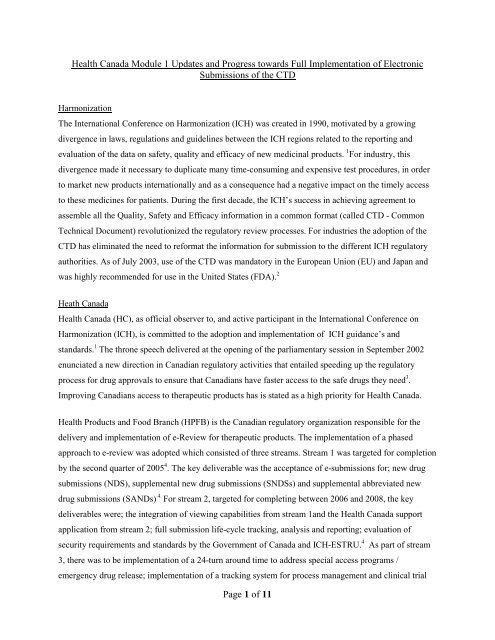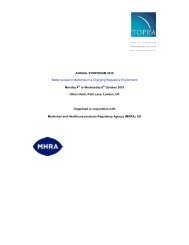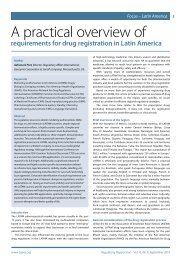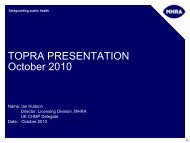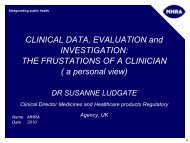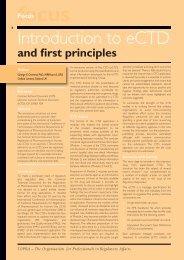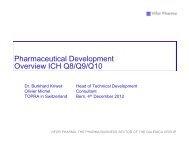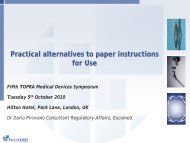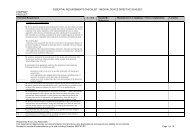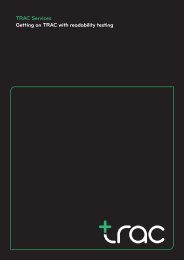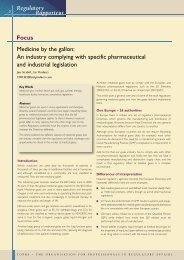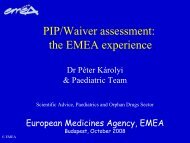Health Canada Module 1 Updates and Progess Towards ... - TOPRA
Health Canada Module 1 Updates and Progess Towards ... - TOPRA
Health Canada Module 1 Updates and Progess Towards ... - TOPRA
You also want an ePaper? Increase the reach of your titles
YUMPU automatically turns print PDFs into web optimized ePapers that Google loves.
<strong>Health</strong> <strong>Canada</strong> <strong>Module</strong> 1 <strong>Updates</strong> <strong>and</strong> Progress towards Full Implementation of Electronic<br />
Submissions of the CTD<br />
Harmonization<br />
The International Conference on Harmonization (ICH) was created in 1990, motivated by a growing<br />
divergence in laws, regulations <strong>and</strong> guidelines between the ICH regions related to the reporting <strong>and</strong><br />
evaluation of the data on safety, quality <strong>and</strong> efficacy of new medicinal products. 1 For industry, this<br />
divergence made it necessary to duplicate many time-consuming <strong>and</strong> expensive test procedures, in order<br />
to market new products internationally <strong>and</strong> as a consequence had a negative impact on the timely access<br />
to these medicines for patients. During the first decade, the ICH’s success in achieving agreement to<br />
assemble all the Quality, Safety <strong>and</strong> Efficacy information in a common format (called CTD - Common<br />
Technical Document) revolutionized the regulatory review processes. For industries the adoption of the<br />
CTD has eliminated the need to reformat the information for submission to the different ICH regulatory<br />
authorities. As of July 2003, use of the CTD was m<strong>and</strong>atory in the European Union (EU) <strong>and</strong> Japan <strong>and</strong><br />
was highly recommended for use in the United States (FDA). 2<br />
Heath <strong>Canada</strong><br />
<strong>Health</strong> <strong>Canada</strong> (HC), as official observer to, <strong>and</strong> active participant in the International Conference on<br />
Harmonization (ICH), is committed to the adoption <strong>and</strong> implementation of ICH guidance’s <strong>and</strong><br />
st<strong>and</strong>ards. 1 The throne speech delivered at the opening of the parliamentary session in September 2002<br />
enunciated a new direction in Canadian regulatory activities that entailed speeding up the regulatory<br />
process for drug approvals to ensure that Canadians have faster access to the safe drugs they need 3 .<br />
Improving Canadians access to therapeutic products has is stated as a high priority for <strong>Health</strong> <strong>Canada</strong>.<br />
<strong>Health</strong> Products <strong>and</strong> Food Branch (HPFB) is the Canadian regulatory organization responsible for the<br />
delivery <strong>and</strong> implementation of e-Review for therapeutic products. The implementation of a phased<br />
approach to e-review was adopted which consisted of three streams. Stream 1 was targeted for completion<br />
by the second quarter of 2005 4 . The key deliverable was the acceptance of e-submissions for; new drug<br />
submissions (NDS), supplemental new drug submissions (SNDSs) <strong>and</strong> supplemental abbreviated new<br />
drug submissions (SANDs) 4. For stream 2, targeted for completing between 2006 <strong>and</strong> 2008, the key<br />
deliverables were; the integration of viewing capabilities from stream 1<strong>and</strong> the <strong>Health</strong> <strong>Canada</strong> support<br />
application from stream 2; full submission life-cycle tracking, analysis <strong>and</strong> reporting; evaluation of<br />
security requirements <strong>and</strong> st<strong>and</strong>ards by the Government of <strong>Canada</strong> <strong>and</strong> ICH-ESTRU. 4 As part of stream<br />
3, there was to be implementation of a 24-turn around time to address special access programs /<br />
emergency drug release; implementation of a tracking system for process management <strong>and</strong> clinical trial<br />
Page 1 of 11
adverse event monitoring <strong>and</strong> implementation of end-to-end solution that will incorporate ICH<br />
guidelines 4 . Iimplementation of the structured approach to the eCTD was undertaken in three stages; cosubmission<br />
filing format (no longer accepted as of 20 January 2010), hybrid filing format (full eCTD<br />
format accompanied by <strong>Module</strong> 1 <strong>and</strong> 2 in paper format), <strong>and</strong> electronic only filing format. 5<br />
The ICH - Multi-disciplinary Group 2 (M2) Expert Working Group (EWG) was established in 1994 to<br />
facilitate international electronic communication by evaluating <strong>and</strong> recommending, open <strong>and</strong> nonproprietary<br />
- to the extent possible - electronic st<strong>and</strong>ards for the transfer of regulatory information<br />
(ESTRI) to meet the requirements of the pharmaceutical companies <strong>and</strong> regulatory authorities. 6 The<br />
International Conference on Harmonization of Technical Requirements for the Registration of<br />
Pharmaceuticals for Human Use (ICH) first developed a st<strong>and</strong>ardized message for the content of the<br />
submissions, the Common Technical Document (CTD) 6 . Shortly after, the electronic, XML-version<br />
version of this message was created (eCTD).<br />
The HPFB <strong>and</strong> industry is committed to achieve the long-term goal of an automated st<strong>and</strong>ards-based<br />
information technology environment for the exchange, review, <strong>and</strong> management of information<br />
supporting the process for the regulatory activities throughout the product lifecycle 4 . The HPFB vision is<br />
to implement a fully electronic submission <strong>and</strong> review environment of all regulatory documents <strong>and</strong> data;<br />
<strong>and</strong>, where possible, the elimination of future paper-based submissions. 4 The HPFB <strong>and</strong> government as a<br />
whole have identified information technology as a key element of a modern organization <strong>and</strong> recognize<br />
its importance to the future of the government workplace. The HPFB has made progress in moving<br />
toward electronic systems, particularly in the area of submission review. However, there are opportunities<br />
to improve on current systems as well as the development of new systems to fill gaps, provide improved<br />
service <strong>and</strong> interaction, as well as increase efficiency in current processes. A few years ago, there was a<br />
significant shift in the drivers at the international level for the e-submission initiative 2 . The numbers of<br />
non-ICH parties are increasing seeking inclusion in the harmonization process.<br />
The Food <strong>and</strong> Drug Administration (FDA) now had a requirement to use <strong>Health</strong> Level 7 (HL7) in the<br />
st<strong>and</strong>ard development process as the st<strong>and</strong>ard development organization. 2 RPS, an HL7 st<strong>and</strong>ard, is a<br />
single message structure that can be used globally for all regulated products, including<br />
biopharmaceuticals, medical devices, veterinary medicines, <strong>and</strong> food which offers two-way<br />
communication between the submitter <strong>and</strong> the regulatory agency, whereas eCTD is a one-way<br />
communication tool. 2 In addition, with RPS, previously submitted documents will not have to be<br />
resubmitted in marketing applications, as it will be possible to apply previously submitted documents to<br />
the marketing application. This will spare submitters from having to retest hyperlinks <strong>and</strong> bookmarks<br />
Page 2 of 11
ecause the agency will already have those documents. Lifecycle management will also improve with<br />
RPS as it will be possible to change granularity <strong>and</strong> move documents, steps that are not possible with<br />
eCTD. This created the conditions to have multiple competing st<strong>and</strong>ards <strong>and</strong> loss of harmonization. The<br />
solution was to join forces <strong>and</strong> propose an all inclusive solution to cover all interested parties, countries<br />
<strong>and</strong> product lines. Agreements were put in place between St<strong>and</strong>ard Development Organizations (SDO). 2<br />
The end product will be the International Organization for St<strong>and</strong>ardization (ISO) st<strong>and</strong>ards created in<br />
collaboration with ICH, the European Committee on St<strong>and</strong>ardization (CEN), <strong>and</strong> HL7. 2 Revisions to the<br />
<strong>Module</strong> 1 structure in the CTD format were required in order for <strong>Health</strong> <strong>Canada</strong> to adopt the eCTD v4.0<br />
Regulated Product Submissions (RPS).<br />
<strong>Health</strong> <strong>Canada</strong> has completed the transition to the acceptance of st<strong>and</strong>-alone submissions in eCTD format<br />
<strong>and</strong> now accepts all regulatory activities in eCTD electronic-only filling format that are filed in<br />
compliance with the ICH eCTD specification. Sponsors filing a regulatory activity in eCTD format must<br />
comply with the specifications included in; Draft Guidance Document: Preparation of Drug Regulatory<br />
Activities in eCTD (version date March 30 th , 2012) 7 , Guidance for Industry: Creation of the Canadian<br />
<strong>Module</strong> 1 Backbone 8 , as well as ICH M2 EWG Electronic Common Technical Document Specification<br />
(Version 3.2.2, July 16, 2008) 6 <strong>and</strong> the corresponding Questions <strong>and</strong> Answers, developed by the ICH M2<br />
Expert Working Group (EWG) .<br />
The following drug submission information is eligible for filing in eCTD format; New Drug Submission<br />
(NDS), Abbreviated New Drug Submission (ANDS), Supplement to a New Drug Submission (SNDS),<br />
Supplement to an Abbreviated New Drug Submission (SANDS), Notifiable Change (NC) only when<br />
related to previously filed submissions in eCTD format, Forms summarizing the Changes to Marketed<br />
Human New Drug Products: Notices of Change (Level III), only when related to previously filed<br />
submissions in eCTD format, <strong>and</strong> Periodic Safety Update Reports (PSURs) requested during the premarket<br />
review process by Therapeutic Products Directorate (TPD) <strong>and</strong> Biologics <strong>and</strong> Genetic Therapies<br />
Directorate (BGTD). 10<br />
The regulatory activities currently not accepted in eCTD format by <strong>Health</strong> <strong>Canada</strong> include; Clinical Trial<br />
Application or Amendment (CTA or CTA-A);Natural <strong>Health</strong> Product (NHP) application; Drug Master<br />
File (DMF); Site Reference File (SRF); Medical Devices - License Application or Amendment (LAp or<br />
LAm); Lot Release documentation; Adverse Reaction Reports for MHPD. 7<br />
Page 3 of 11
<strong>Module</strong> 1Changes<br />
<strong>Module</strong> 1 contains region specific administrative <strong>and</strong> local prescribing information. Table 1 contains the<br />
current regional requirements for the eCTD submission in <strong>Canada</strong>. As displayed in Table 1, <strong>Module</strong> 1<br />
identifies place holders, defined by numerical items listed in <strong>Module</strong> 1 table of contents (ToC), for all<br />
administrative <strong>and</strong> product information documentation. The ToC listing all documents includes in<br />
<strong>Module</strong>s 1-5 should be placed in section 1.1 1 . The ToC is consistent with the harmonized CTD; the eCTD<br />
also provides a harmonized technical solution to implementing the CTD electronically.<br />
<strong>Module</strong> 1 has undergone significant revision in the last draft. Notably, 1.0 -Administrative Information<br />
now contains a lifecycle management table (1.0.2), which is a specific requirement for filing submissions<br />
or applications in the eCTD format. Life Cycle Management is comprised of three layers; drug product<br />
layer (Dossier), submission layer (regulatory activity) <strong>and</strong> the document layer. A life-cycle management<br />
plan should address early drug development, submission filing, monitoring after market authorization,<br />
<strong>and</strong> all issues that may arise during a drug’s lifetime. 7 The ICH Guidance “Granularity Document Annex<br />
to M4: Organization of the CTD” outlines three levels of allowed granularity for Quality Overall<br />
Summary (QOS). 11 According to ICH, the mid-range granularity consists of separate documents under<br />
each of the following heading sections; Introduction, Drug Substance, Drug Product, Appendices <strong>and</strong><br />
Regional. 11 This approach is a compromise between the single file <strong>and</strong> maximum granularity options. It<br />
would include the highest level headings of the QOS, allowing for fewer files to maintain under lifecycle<br />
management principles. <strong>Health</strong> <strong>Canada</strong> does not currently use comprehensive planning for the entire lifecycle<br />
of a drug. Although decisions by <strong>Health</strong> <strong>Canada</strong> take into account the history <strong>and</strong> the future of a<br />
drug, authorization <strong>and</strong> monitoring take place in discrete steps that are not integrated to form a cohesive<br />
drug life-cycle management plan however can require that drug sponsors file a life-cycle management<br />
plan with their submission to identify the tools <strong>and</strong> activities that may be necessary during the drug’s<br />
development, review, <strong>and</strong> entry onto the market. A significant amount of additional background material<br />
has been added, including: a figure illustrating an eCTD Structure showing multiple sequences, an<br />
example of the Life Cycle Management Table, a series of tables illustrating valid <strong>and</strong> invalid scenarios for<br />
life cycle management scenarios for operation attributes. 7 Companies are using a variety of approaches<br />
for the presentation of the QOS. Experience shows that health authorities have accepted each of these<br />
approaches without expressing a consistent preference. 11 The QOS is a summary document that follows<br />
the scope <strong>and</strong> outline of the Body of Data in <strong>Module</strong> 3 -Quality. <strong>Module</strong> 3.2.R Regional Information now<br />
contains a yearly biological product report (YBPR) – for Biologics <strong>and</strong> Genetic Therapies Directorate<br />
(BGTD) only 7 . There are currently is no clear regulatory guidance regarding eCTD-specific topics which<br />
Page 4 of 11
facilitate the submission <strong>and</strong> subsequent lifecycle management of the QOS in electronically filed<br />
registration applications. 11<br />
Administrative information (1.2 – 1.2.9) now contains; intellectual property information, good<br />
manufacturing processes (GMP) <strong>and</strong> establishment of licensing information have been broken down into<br />
twelve separate modules (1.2.5 – 1.2.5.7). As of 2008, the regulatory experts from the European Union<br />
<strong>and</strong> <strong>Canada</strong> are able to exchange confidential information about the authorization <strong>and</strong> safety of<br />
medicines. 12 <strong>Module</strong> 1.2.6 authorization for sharing information has replaced <strong>Module</strong> 1.2.6 letter of<br />
access in the revised guidance. DMF <strong>and</strong> Site Reference Files (SRF) should be provided in the section.<br />
Confidentiality arrangements were agreed between the European Commission <strong>and</strong> the European<br />
Medicines Agency (EMEA) on the one side <strong>and</strong> the <strong>Health</strong> Products <strong>and</strong> Food Branch of <strong>Health</strong><br />
<strong>Canada</strong>. 12 The partners will be able to exchange confidential information, for instance on safety issues<br />
with marketed medicines <strong>and</strong> therapeutic products being developed or considered for authorization. The<br />
potential benefits of this exercise are expected to include: accelerated access of patients to new <strong>and</strong><br />
innovative medicines; improved performance <strong>and</strong> safety as a result of the involvement of the best<br />
available regulatory expertise from both the EU <strong>and</strong> <strong>Canada</strong>.<br />
The status of outst<strong>and</strong>ing Post-Marketing commitments, that are not subject to the Notice of Compliance<br />
with conditions (NOC/c) policy, either because they do not meet the requirements or because they are<br />
Level II changes, over the lifecycle of a product, in tabular form in the Post- Authorization Information<br />
section (1.2.8). 7<br />
Product information, formerly product labeling (1.3) has seen the addition of; the Investigator Brochure<br />
(IB), Reference Product Labeling, Certified Product Information (CPID) <strong>and</strong> a Look-alike / Sound alike<br />
Assessment (1.3.7) <strong>and</strong> Pharmacovigilance Information (1.3 – 1.3.7). LA/SA names with spelling<br />
similarities <strong>and</strong>/or similar phonetics tend to create confusion for the <strong>Health</strong> Products <strong>and</strong> Food Branch<br />
(HPFB) in its review <strong>and</strong> analysis of a health product name. 13 Furthermore, such names may constitute a<br />
tangible risk to Canadians health by increasing the potential for errors in the prescription, dispensing or in<br />
the administration of a drug. <strong>Health</strong> <strong>Canada</strong> Summaries (1.4) has been revised. The CPID formerly filed<br />
in 1.4.1 has been moved to 1.3.6. In its place are Protocol Safety <strong>and</strong> Efficacy Assessment Templates –<br />
Clinical Trial Application (PSEAT-CTA) is listed. In 2008, the PSEAT-CTA replaced the Preclinical <strong>and</strong><br />
Clinical Evaluation Report Template (PCERT) listed in Appendix 4 of the Guidance for Clinical Trial<br />
Sponsors – Clinical Trial Applications posted in June 2003. 14<br />
Page 5 of 11
A Multidisciplinary Tabular Summary section (1.4.3) has been added 1 . The title of <strong>Module</strong> 1.6 has been<br />
changed from Electronic Review Documents to Regional Clinical Information <strong>and</strong> now contains<br />
comparative bioavailability information for pivotal comparative bioavailability (bioequivalence) studies<br />
(1.6.1). <strong>Module</strong> 1.7 Clinical Trial Application <strong>and</strong> Clinical Trial Application Amendment (CTA-A)<br />
Specific Requirements has been added. 7 The section includes; submission rationale / brief (1.7.1), study<br />
protocol (1.7.2), informed consent forms (1.7.3), Canadian research ethics board (REB) refusals (1.7.4)<br />
<strong>and</strong> information on prior-related applications (1.7.5). A section for appendices has been added (1.A). The<br />
electronic review package (1.A.1) is the only item listed in this section. All electronic media submitted to<br />
support the drug submission or application should be placed in this section.<br />
<strong>Health</strong> <strong>Canada</strong> also made major changes in its <strong>Module</strong> 1 metadata, including adding elements applicant,<br />
product-name, dossier-identifier, dossier-type, regulatory-activity-type, regulatory-activity-lead <strong>and</strong><br />
removing elements submission-identifier, <strong>and</strong> submission-date. The eCTD Regulatory Transaction<br />
Information section allows information about the submission <strong>and</strong> sequence to be included in a form which<br />
is easily processed. 7 This information, broadly categorized as metadata, allows <strong>Health</strong> <strong>Canada</strong> to more<br />
effectively manage incoming electronic submissions <strong>and</strong> lowers the possibility of errors introduced by<br />
manually re-entering this key data. On the technical front, the revised eCTD guidance calls for a technical<br />
change to the use of a Schema instead of DTD. 9 The current implementation timeline to accept regulatory<br />
activities built with the revised Canadian <strong>Module</strong> 1 Schema is late September 2012 9 . As of March 21,<br />
2013, <strong>Health</strong> <strong>Canada</strong> will no longer be accepting regulatory activities built with the old Canadian <strong>Module</strong><br />
1 DTD 9 .<br />
Periodic Safety Update Reports (PSURs) requested during the pre-market review process by Therapeutic<br />
Products Directorate (TPD) <strong>and</strong> Biologics <strong>and</strong> Genetic Therapies Directorate (BGTD) may be filed in<br />
eCTD format. 15 PSURs submitted to the Marketed <strong>Health</strong> Products Directorate (MHPD) may not be filed<br />
in eCTD format. SNDS <strong>and</strong> SANDS are not longer limited to being filed when the original NDS or<br />
ANDS was in eCTD format. 15 <strong>Health</strong> <strong>Canada</strong> will now allow a sponsor to switch to eCTD format for any<br />
major submission (like the FDA <strong>and</strong> EMEA). 10<br />
Next Steps<br />
At this time, the plan <strong>and</strong> timeline for implementation includes; publication of the final version of this<br />
guidance <strong>and</strong> the final Canadian <strong>Module</strong> 1 Schema by end of March 2012, regulatory activities built with<br />
the revised Canadian <strong>Module</strong> 1 Schema to be accepted by end of September 2012, transition of eCTD<br />
Page 6 of 11
submissions to the proposed <strong>Module</strong> 1 format by March 21, 2013 at which time <strong>Health</strong> <strong>Canada</strong> will no<br />
longer be accepting regulatory activities built with the Canadian <strong>Module</strong> 1 format. 4<br />
HC-FDA Regulatory Cooperation Council (RCC) Initiatives<br />
The <strong>Health</strong> <strong>Canada</strong> -FDA Regulatory Cooperation Council (RCC) released the Joint Action Plan on<br />
Regulatory Cooperation on December 7, 2011. 16 The Joint Action Plan is a practical first step to increased<br />
regulatory cooperation between the United States <strong>and</strong> <strong>Canada</strong>. Implementation of a common electronic<br />
submission gateway, common monographs for over-the-counter drug (OTC) <strong>and</strong> good manufacturing<br />
processes are the first three RCC initiatives. Action plans for each initiative were released in May 2012<br />
<strong>and</strong> are expected to be completed within two years. 16<br />
Implementation of a Common Electronic Submission Gateway, using the current US gateway that allows<br />
industry clients the ability to submit large size electronic documents seamlessly to <strong>Health</strong> <strong>Canada</strong> <strong>and</strong> US<br />
FDA with a view toward further catalyzing increased review collaboration between the two regulatory<br />
agencies, increased efficiency of sovereign decision making, <strong>and</strong> improved access to the introduction of<br />
medicines for patients in both countries. Current plans include a pilot of this the e-submission gateway<br />
process this summer with the intent of going live by the end of 2012. 16<br />
The objectives of the RCC monograph alignment working group are to conduct a pilot program to<br />
develop aligned monograph elements for a selected over-the-counter (OTC) drug category (e.g. aligned<br />
directions, warnings, indications <strong>and</strong> conditions of use). Subsequently, the plan is to develop<br />
recommendations to determine the feasibility of an ongoing mechanism for alignment in review <strong>and</strong><br />
adoption of these OTC drug monograph elements. 16 Finally, there is a plan to enhance collaboration on<br />
enforcement <strong>and</strong> compliance by increasing mutual reliance on each other’s routine surveillance good<br />
manufacturing practices (GMP) inspection reports of manufacturing facilities for drugs <strong>and</strong> personal<br />
products, rather than having to conduct unnecessarily duplicative inspections in the other country. 16<br />
Conclusion<br />
<strong>Health</strong> <strong>Canada</strong> has made a great deal of progress towards the goal of moving to an eCTD only submission<br />
process however there is still work to do. At this time, <strong>Health</strong> <strong>Canada</strong> is still accepting regulatory<br />
submissions using the hybrid format. 17 Through the formation of the RCC, <strong>Health</strong> <strong>Canada</strong> <strong>and</strong> the FDA<br />
will be able to align to common international data st<strong>and</strong>ard requirements (e.g. Regulated Product<br />
Submissions) to support two-way communications <strong>and</strong> submission lifecycle management. The FDA is<br />
Page 7 of 11
much further along in the implementation electronic submission process <strong>and</strong> has a wealth of experience to<br />
share. In a time of budget cuts that have affected both countries regulatory bodies, modernizing the<br />
regulatory <strong>and</strong> policy process in a way that fosters collaboration both now <strong>and</strong> in the future has the<br />
potential to not only reduce costs but to increase quality <strong>and</strong> safety in the process. Careful attention must<br />
be paid to ensure the st<strong>and</strong>ards adopted through harmonization do not result in a lowering of the current<br />
guidelines.<br />
Table 1: Regional Information for <strong>Canada</strong> – Required for the eCTD.<br />
Regional Information for <strong>Canada</strong><br />
Administrative Information <strong>and</strong> Prescribing Information<br />
1.1 Table of Contents (<strong>Module</strong>s 1-5)<br />
1.2 Application Information<br />
1.2.1 Drug Submission Application Form (HC/SC 3011)<br />
1.2.2 Drug Submission Fee Application Form<br />
1.2.3 Submission Certification Form<br />
1.2.4 Patent Information<br />
1.2.5 Good Manufacturing Practices (GMP) <strong>and</strong> Establishment Licensing (EL) Information<br />
1.2.6 Letters of Access<br />
1.2.7 International Registration Status<br />
1.2.8 Other Application Information<br />
1.3 Product Labeling<br />
1.3.1 Product Monograph<br />
1.3.2 Inner <strong>and</strong> Outer Labels<br />
1.3.3 Non-Canadian Package Inserts<br />
1.4 <strong>Health</strong> <strong>Canada</strong> Summaries<br />
1.4.1 Certified Product Information Document<br />
1.4.2 Comprehensive Summary: Bioequivalence<br />
1.5 Environmental Assessment Statement 10<br />
1.6 Electronic Review Documents<br />
2 Common Technical Document Summaries<br />
2.3 Quality Overall Summary - Chemical Entities<br />
(QOS-CE) <strong>and</strong> Analytical Procedures <strong>and</strong><br />
Validation Information Summaries<br />
3.2.R.1<br />
Quality<br />
Production Documentation<br />
3.2.R.1.1 Executed Production Documents<br />
3.2.R.1.2 Master Production Documents<br />
3.2.R.2<br />
3.2.R.3<br />
Medical Devices<br />
Executed Batch Records (not applicable<br />
to Positron-Emitting<br />
Radiopharmaceuticals (PERs))<br />
(applicable to PERs only)<br />
Lot Release Documentation<br />
Page 8 of 11
References<br />
1.ICH Secretariat, 2008, “The value <strong>and</strong> benefits of ICH to Drug Regulatory Authorities – Advancing<br />
harmonization for Better <strong>Health</strong>”<br />
2. Group on Electronic Regulatory Affairs (GERD) Activities Recommendations: White Paper; 31-Oct-<br />
2012.<br />
3. Government of <strong>Canada</strong>, 2005, “Regulations <strong>and</strong> Beyond: Progress on <strong>Canada</strong> Therapeutic Access<br />
Strategy”.<br />
4. <strong>Health</strong> Products <strong>and</strong> Food Branch (HPFB) strategic frameworks: the 2007-2012 Strategic Plan:<br />
http://www.hc-sc.gc.ca/ahc-asc/pubs/hpfb-dgpsa/map-feuille-2007-2012-eng.php<br />
5. Release of <strong>Health</strong> <strong>Canada</strong>'s Revisions to"1.6 Electronic Review Documents" in Draft Guidance for<br />
Industry: Preparation of New Drug Submissions in the CTD Format.25-Feb-2008: http://www.hcsc.gc.ca/dhp-mps/prodpharma/applic-dem<strong>and</strong>e/guide-ld/ctd/notice_avis_ctd-eng.php<br />
6. ICH-M2 Expert Working Group; Electronic Common Technical Document Specifications V 3.2.2; 16-<br />
Jul-2008.<br />
7. Draft Guidance Document: Preparation of Drug Regulatory Activities in Electronic Common Technical<br />
Document (eCTD) 30-Mar-12: http://www.hc-sc.gc.ca/dhp-mps/consultation/drugmedic/ctd_prep_draft_rev_ebauche_nds_2011-eng.php<br />
8. Draft Guidance for Industry: Creation of the Canadian <strong>Module</strong> 1 Backbone 30-Mar-12: http://www.hcsc.gc.ca/dhp-mps/consultation/drug-medic/draft_ebauche_ectd_mod1_guide-ld-eng.php<br />
9. Draft Canadian <strong>Module</strong> 1 Schema Version 2.1: http://www.hc-sc.gc.ca/dhp-mps/consultation/drugmedic/notice_draft_ectd_schema_ebauche_avis-eng.php<br />
Page 9 of 11
10. Notice - Increased Scope of Submissions being accepted in Electronic Common Technical Document<br />
(eCTD) electronic-only filing format: 30-Sep-11: http://www.hc-sc.gc.ca/dhp-mps/prodpharma/applicdem<strong>and</strong>e/guide-ld/ctd/ectd/notice_scope_ectd_avis_augm-eng.php<br />
11. Boehringer Ingelheim, Glaxo-Smith Kline, Image Solutions Inc, Lundbeck, Inc, Merck, Pfizer, sanofiaventis,<br />
Takeda, <strong>and</strong> ePharmaCMC; March, 2010, Industry Book of Knowledge Practical Considerations<br />
for eCTD Submissions: Quality Overall Summary (QOS) for Marketing Applications, QOS eCTD/CMC<br />
v1.2.<br />
12. <strong>Health</strong> <strong>Canada</strong>, EMEA; Closer ties on medicines safety between European <strong>and</strong> Canadian regulatory<br />
authorities, 2008: http://www.hc-sc.gc.ca/dhp-mps/alt_formats/hpfb-dgpsa/pdf/prodpharma/announce_hcec-emea-sc_annonce-eng.pdf<br />
13. Release of Revised Guidance Document: Drug Name Review: Look-alike Sound-alike<br />
(LA/SA) <strong>Health</strong> Product Names: 31-Oct-2005: http://www.hc-sc.gc.ca/dhp-mps/brgtherap/proj/alikesemblable/lasa-pspcs_post_market-comm_guidance-directive_2-eng.php<br />
14. Therapeutic Products Directorate (TPD) <strong>and</strong> Biologic <strong>and</strong> Genetic Therapies Directorate (BGTD)<br />
Protocol Safety <strong>and</strong> Efficacy Assessment Template-Clinical Trial Application (PSEAT-CTA), 2008:<br />
http://www.hc-sc.gc.ca/dhp-mps/prodpharma/applic-dem<strong>and</strong>e/templatesmodeles/notice_pseat_cta_avis_meiep_dec-eng.php<br />
15. Notice Regarding the Implementation of a Risk-Prioritized Periodic Safety Update Report Regulatory<br />
Review Pilot at <strong>Health</strong> <strong>Canada</strong>, including the adoption of International Conference on Harmonization<br />
(ICH) Guidance Clinical Safety Data Management: Periodic Safety Update Reports for Marketed Drugs -<br />
ICH Topic E2C, as of April 1, 2010: http://www.hc-sc.gc.ca/dhp-mps/prodpharma/applic-dem<strong>and</strong>e/guideld/vigilance/notice_avis_psur-rrp_pecr-rppv-eng.php<br />
16. <strong>Health</strong> <strong>Canada</strong> <strong>and</strong> FDA; Common Electronic Submissions Gateway (ESG) Work Plan - Proposal to<br />
explore <strong>and</strong> develop joint proposals to identify on-going systemic alignment mechanisms between the<br />
U.S. Food <strong>and</strong> Drug Administration (FDA) <strong>and</strong> <strong>Health</strong> <strong>Canada</strong> (HC):<br />
http://actionplan.gc.ca/eng/feature.aspmode=preview&pageId=456<br />
17. Non-electronic Common Technical Document (eCTD) Hybrid Pilot 27-Apr-12: http://www.hcsc.gc.ca/dhp-mps/prodpharma/applic-dem<strong>and</strong>e/guide-ld/ctd/ectd/notice_non_ectd_hybrid_pilot_aviseng.php<br />
Page 10 of 11
Page 11 of 11


